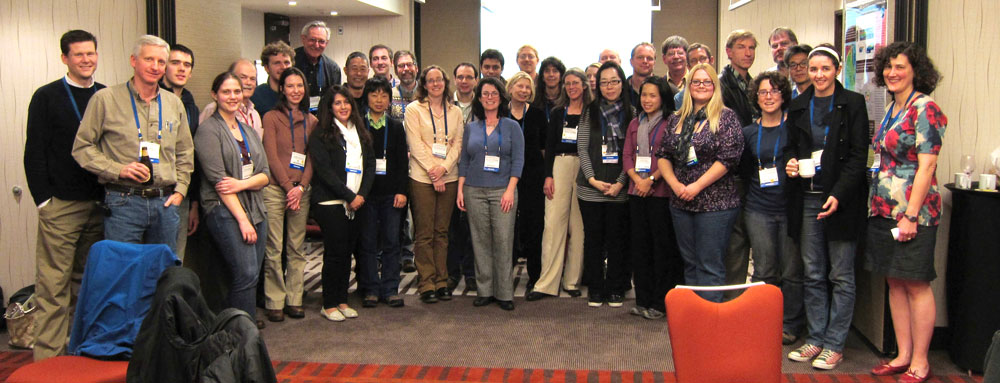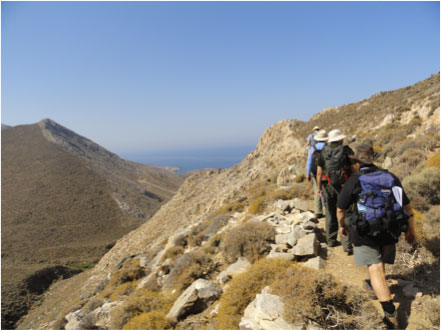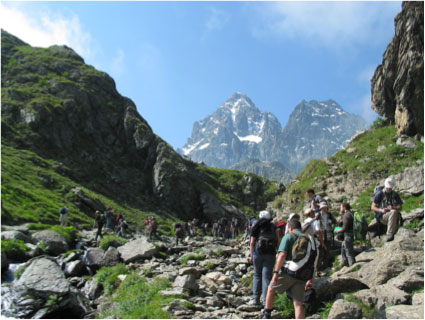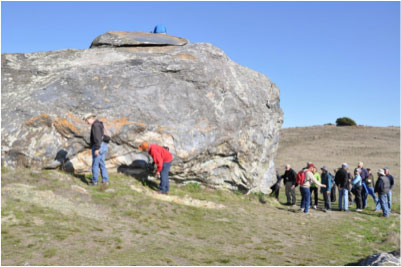AGU Fall Meeting 2011, San Francisco
1Pennsylvania State University; 2University of Maryland; 3University of Rhode Island

Figure 1. GeoPRISMS ExTerra mini-workshop participants.
On the evening of December 7, 2011, about 35 geoscientists convened in the ExTerra mini-workshop during the fall AGU Meeting to discuss how to integrate the study of exhumed rocks into the GeoPRISMS Subduction Cycles and Deformation (SCD) initiative (Figure 1). After introductory presentations by the convenors and keynote speaker Brad Hacker (University of California, Santa Barbara), workshop participants divided into four groups based on different types of exhumed terranes: subducted slab, mantle wedge, arc crust, and fault systems. The group discussion was divided into two areas: identification of scientific objectives and organizational strategies. Details of the outcomes from each discussion group are outlined at http://www.geoprisms.nineplanetsllc.com/scd/exterra.html. This is an ongoing discussion leading to a white paper contribution to the GeoPRISMS SCD Science Plan, and we invite all interested parties to participate!
What is ExTerra?
The NSF GeoPRISMS Science Plan for the SCD Initiative identified the study of exhumed terranes as an important component of subduction zone research. It remains to be determined how to best integrate the study of exhumed terranes and high pressure rocks into GeoPRISMS SCD. GeoPRISMS largely follows the very effective model used previously by MARGINS of building a research program around a few locations, referred to as primary sites, atactive subduction, these features are buried deep beneath the surface. Of necessity, exhumation most often occurs during or following the death of a subduction zone. The nature of exhumation processes is such that entire subduction zones are rarely if ever exposed in a single location, requiring fieldwork to be conducted at multiple locations, and most often by multiple research groups using different techniques and approaches, before a comprehensive range of pressure and temperature conditions can be represented. Currently, the study of exhumed terranes is included in the GeoPRISMS Implementation Plan as a thematic study. The goal of this mini-workshop and the resulting white paper is to explore how we can best organize research on exhumed terranes under the umbrella of GeoPRISMS SCD such that we might accomplish more as a group than we could as individuals working independently.

Figure 2. SOTA fieldtrip to see Cycladic subduction zone rocks on the island of Syros, Greece.
What can studies of exhumed systems contribute to GeoPRISMS?
The integration of studies of exhumed systems through GeoPRISMS can organize individual efforts towards major interdisciplinary objectives. Integration of data from multiple sites allows coverage of a broad range of conditions not observable at a single site. Studies of exhumed systems under the umbrella of GeoPRISMS have the potential to link experiments and seismic observation to physical reality, adding the components of space and time. Collaboration and communication between different communities represented within GeoPRISMS allow sample and data collection to be tuned to serve the needs of other groups (geochemists helping seismologists, petrologists helping modelers, etc.).

Figure 3. ILP Subduction channel workshop fieldtrip to the Monviso Ophiolite, W. Alps, Italy.
Target areas
Four target areas have been identified as significant to improving our understanding active subduction processes by the study of exhumed terranes: 1) subducted slab, including HP and UHP rocks such as blueschists, eclogites, and metapelites; 2) mantle wedge, including serpentinites, ophiolites, and peridotites; 3) middle and lower arc crust, including granitoids, gabbros, migmatites, gneisses, amphibolites, granulites; and 4) exhumed fault systems, including accretionary prisms.

Figure 4. AGU Fieldtrip to see subduction zone rocks of the Franciscan Complex, CA.
Fostering Interdisciplinary Communication
Several different ideas have been suggested in order to facilitate communication among different geoscientists. One idea is to hold focused, interdisciplinary field trips in order to provide the opportunity for non-field geologists to observe exhumed rocks and create an environment for exchange of ideas between field geologists and non-field geologists. Another idea is to create a sample repository and associated database that will allow sample collectors to connect with those who have use for rock samples. For example, experimental petrologists can make use of a sample repository to find materials for their experiments.
Challenges
We recognize that there are many challenges facing the integration of the study of exhumed terranes into GeoPRISMS. How do we open the dialog between petrologists, geophysicists, and modelers? How can studies of worldwide exhumed terranes be related to current GeoPRISMS focus sites? GeoPRISMS is a small program, and we will need to leverage with funds from outside sources.
Go to the mini-workshop webpage
Reference information
GeoPRISMS Newsletter, Issue No. 28, Spring 2012. Retrieved from http://geoprisms.nineplanetsllc.com
